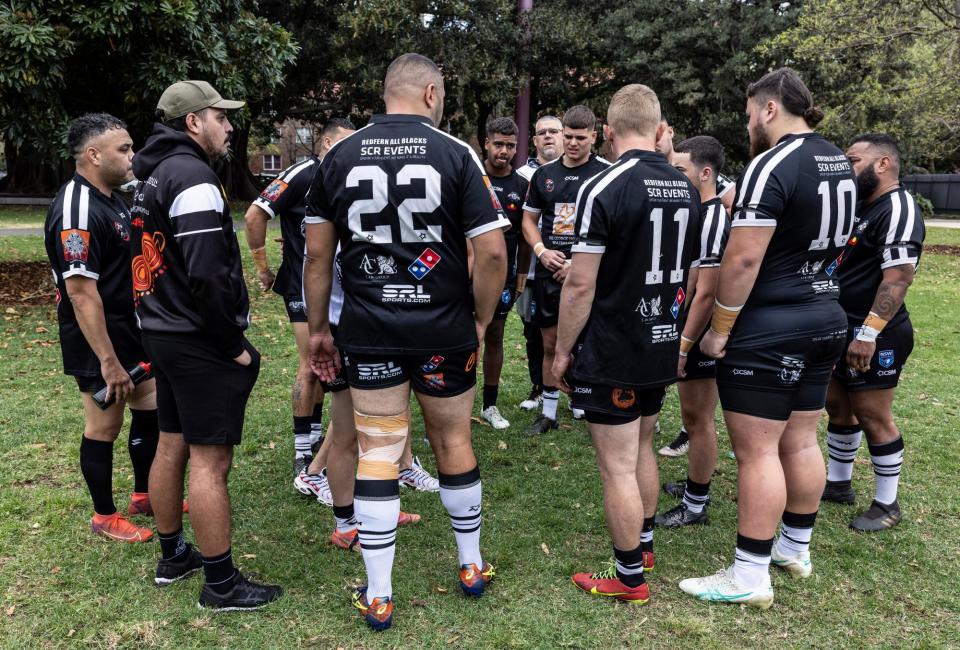
On Sunday, an overcast, cool spring day, Redfern Oval in Sydney represented a time capsule for working class inner-city rugby league. Classic Australian rock blared on the speakers, entry to the ground was a mere $2 and it was cash-only for the big line of patrons waiting for the sausage sizzle.
The Redfern All Blacks A-Reserve team has reached the 2024 South Sydney District Rugby League grand final – in the same year that Australia’s oldest Indigenous rugby league club is celebrating its 80th anniversary, commemorating its official entry into the South Sydney Rugby League competition in 1944.
For Nathan Moran, a Birripi-Dunghutti man and the CEO of the Metropolitan Local Aboriginal Land Council, the RABs and rugby league in the area have deep meaning for his community. “Footy and boxing were always our avenue out – literally off the mission and then later as a chance to get ahead,” says Moran, a former All Blacks coach and player. “It’s not just fun for us, it’s an escape and a movement.”
All Blacks fans and players are easy to spot in the crowd, many wearing white hoodies, which read: “We keep the ball in motion.” It is a line from their team song that references the DNA of the club – the now defunct Tweed Heads All Blacks who came down to Sydney to play exhibition matches in the 1930s, inspiring the Aboriginal community in Redfern to start their own team.
The club’s rich history was visible on Sunday – at the community elders tent, Moran was surrounded by elderly Redfern All Blacks pioneers including John Young, also known as “Uncle Blackdog”. Young is almost 70 and has been involved for 47 years as a player and coach and, today, as the team’s strapper, taping up ankles and other injuries.
He takes great pride in participating in the club’s circle of life and pointed out the All Blacks No 17, a tall, strong forward known as “Bubba”. “He’s just like his father and brother – quiet off the field but tough on it,” he says. “I coached ‘Bubba’ in nappy grade and now I am strapping him in men’s footy. Makes me so proud.”
For Keith “Kip” Munro, the club’s junior convenor, helping to keep the club healthy has been a personal mission. When the All Blacks were perilously down to five teams, he committed to rebuild to 20; two years ago the club reached that goal and is thriving again, building role models at all age levels and providing cultural affirmation.
“We’ve been a beacon, a safe place for community,” says Munro. “A place where you can be yourself, play entertaining footy and identify with that sense of pride of what we’ve built over the last 80 years.”
The Redfern All Blacks have been at the centre of the Aboriginal and Torres Strait Islander rights journey, from exclusion to inclusion and integration via maintaining their cultural identity in a mainstream league. Once restricted to missions and reserves by the Aborigines Protection Act, in the 1920s, Aboriginal people began to move to Redfern to work at the Eveleigh Railway Workshops and Botany Road factories.
After the official birth of the All Blacks in 1944, the club provided a unifying backbone for families from different NSW Aboriginal nations and helped spawn the creation of the first Aboriginal-controlled legal, housing and medical corporations in the early 1970s.
On the field, the Redfern All Blacks have won the South Sydney A-Grade men’s title seven times, while off it they were heavily involved in activism and resistance in the civil rights movement, and the Black Power movement. The club was also scrutinised by ASIO for communist links and provided a rallying point for the death of TJ Hickey and the ensuing riots.
Gathering every week for All Blacks games became an act of defiance in fending off assimilation. The latest challenge is gentrification – the stock of social housing is reducing in the area and many families have moved to Western Sydney and now commute every week to play.
The biggest positive change for the All Blacks according to Munro, has been the success of the female program, with women and girls now comprising 45% of players, including four Australian Jillaroos.
It wasn’t always the case according to community matriarch Aunty Beryl Van-Oploo OAM, still spritely at 82 and who first came to Redfern aged 16 from Walgett. Aunty Beryl notes that when it comes to the All Blacks, she has: “Lived it, seen it, done it.”
“Women never even dreamed of playing but we used to fundraise, cook and wash and iron jerseys all around Eveleigh and Louis Streets on ‘The Block’,” she says. “It’s great to see that our young girls now have choices.”
The All Blacks fought bravely on Sunday but, despite the loud crowd support, go down in a close match 16-12 to Mascot. The men in black and white are beaten but not bowed and the loyal Redfern All Blacks fans gave them a standing ovation and commiserative hugs.
“We’re resilient, still here and strong and there’s always next year,” says Moran as he heads home with his family. “We’ve just got to keep the ball in motion.”
Article courtesy of
Source link